1 to 1000 Policy: Controlling Phosphorous Pollution from Tea Farms with Bioretention Cells
Abstract
:1. Introduction
2. Materials and Methods
2.1. Case Study
2.2. Modeling Tool
2.3. Optimization Process
- Step 1: Set the management goal
- Step 2: Apply the verified watershed model
- Step 3: Find the required reduction loads
- Step 4: Allocate loads
- Step 5: Determine the unit reduction loads for tea farms
- Step 6: Apply the verified tea farm model
- Step 7: Determine the optimal size of a controlling facility
3. Results and Discussion
3.1. Preparation of the Verified Model, Model Calibration and Verification
- Watershed-scale model
- 2.
- Site-scale model
3.2. Optimization Results for the Jinggualiao Watershed (Step by Step)
- Step 1: Set the management goal
- Step 2: Apply the verified watershed model
- Step 3: Find the required reduction loads
- Step 4: Allocate loads
- Step 5: Determine the unit reduction loads for tea farms
- Step 6: Apply the verified tea farm model
- Step 7: Determine the optimal size of a controlling facility
3.3. Expected Water Quality Improvement Using Bioretention Cells
4. Conclusions
Supplementary Materials
Author Contributions
Funding
Institutional Review Board Statement
Informed Consent Statement
Data Availability Statement
Conflicts of Interest
Acronyms
| BASINS | Better Assessment Science Integrating Point and Nonpoint Sources platform |
| BMPs | Best Management Practices |
| DEM | Digital elevation model |
| LID | Low impact development |
| MAPE | Mean absolute percentage error |
| SWMM | Storm Water Management Model |
| TMDL | Total Maximum Daily Loads |
| TP | Total phosphorous |
References
- Romstad, E. Team Approaches in Reducing Nonpoint Source Pollution. Ecol. Econ. 2003, 47, 71–78. [Google Scholar] [CrossRef]
- Dowd, B.M.; Press, D.; Los Huertos, M. Agricultural Nonpoint Source Water Pollution Policy: The Case of California’s Central Coast. Agric. Ecosyst. Environ. 2008, 128, 151–161. [Google Scholar] [CrossRef]
- Loucks, D.P.; Van Beek, E. Water Resource Systems Planning and Management: An Introduction To Methods, Models, and Applications; Springer: Cham, Switzerland, 2017. [Google Scholar]
- Rong, Q.; Cai, Y.; Chen, B.; Shen, Z.; Yang, Z.; Yue, W.; Lin, X. Field Management of A Drinking Water Reservoir Basin Based on The Investigation of Multiple Agricultural Nonpoint Source Pollution Indicators in North China. Ecol. Indic. 2018, 92, 113–123. [Google Scholar] [CrossRef]
- Xiang, C.Y.; Wang, Y.; Liu, H.W. A Scientometrics Review on Nonpoint Source Pollution Research. Ecol. Eng. 2017, 99, 400–408. [Google Scholar] [CrossRef]
- Park, M.; Choi, Y.S.; Shin, H.J.; Song, I.; Yoon, C.G.; Choi, J.D.; Yu, S.J. A Comparison Study of Runoff Characteristics of Non-Point Source Pollution from Three Watersheds in South Korea. Water 2019, 11, 966. [Google Scholar] [CrossRef] [Green Version]
- Baker, L.A. Introduction to nonpoint source pollution in the United States and prospects for wetland use. Ecol. Eng. 1992, 1, 1–26. [Google Scholar] [CrossRef]
- Dzikiewicz, M. Activities in nonpoint pollution control in rural areas of Poland. Ecol. Eng. 2000, 14, 429–434. [Google Scholar]
- Liu, R.M.; Wang, J.W.; Shi, J.H.; Chen, Y.X.; Sun, C.C.; Zhang, P.P.; Shen, Z.Y. Runoff characteristics and nutrient loss mechanism from plain farmland under simulated rainfall conditions. Sci. Total Environ. 2014, 468, 1069–1077. [Google Scholar] [CrossRef]
- Kim, H.C.; Yoon, C.G.; Son, Y.K.; Rhee, H.P.; Lee, S.B. Effects of Open Water on The Performance of A Constructed Wetland for Nonpoint Source Pollution Control. Water Sci. Technol. 2010, 62, 1003–1012. [Google Scholar] [CrossRef]
- Jia, Z.; Tang, S.; Luo, W.; Hai, Y. Water Quality Improvement through Five Constructed Serial Wetland Cells and Its Implications on Nonpoint-Source Pollution Control. Hydrol. Sci. J. 2016, 61, 2946–2956. [Google Scholar] [CrossRef]
- Diaz, F.J.; O’Geen, A.T.; Dahlgren, R.A. Agricultural Pollutant Removal by Constructed Wetlands: Implications for Water Management and Design. Agric. Water Manag. 2012, 104, 171–183. [Google Scholar] [CrossRef]
- Roy-Poirier, A.; Champagne, P.; Filion, Y. Bioretention Processes for Phosphorus Pollution Control. Environ. Rev. 2010, 18, 159–173. [Google Scholar] [CrossRef]
- Goh, H.W.; Lem, K.S.; Azizan, N.A.; Chang, C.K.; Talei, A.; Leow, C.S.; Zakaria, N.A. A Review of Bioretention Components and Nutrient Removal under Different Climates-Future Directions for Tropics. Environ. Sci. Pollut. Res. 2019, 26, 14904–14919. [Google Scholar] [CrossRef]
- Osman, M.; Yusof, K.W.; Takaijudin, H.; Goh, H.W.; Malek, M.A.; Azizan, N.A.; Ghani, A.A.; Abdurrasheed, A.S. A Review of Nitrogen Removal for Urban Stormwater Runoff in Bioretention System. Sustainability 2019, 11, 5415. [Google Scholar] [CrossRef] [Green Version]
- Sheng, L.T.; Zhang, Z.; Xia, J.; Liang, Z.; Yang, J.; Chen, X.A. Impact of Grass Traits on The Transport Path and Retention Efficiency of Nitrate Nitrogen in Vegetation Filter Strips. Agric. Water Manag. 2021, 253, 106931. [Google Scholar] [CrossRef]
- Lintern, A.; McPhillips, L.; Winfrey, B.; Duncan, J.; Grady, C. Best Management Practices for Diffuse Nutrient Pollution: Wicked Problems across Urban and Agricultural Watersheds. Environ. Sci. Technol. 2020, 54, 9159–9174. [Google Scholar] [CrossRef]
- Yang, Y.S.; Wang, L. A Review of Modelling Tools for Implementation of the EU Water Framework Directive in Handling Diffuse Water Pollution. Water Resour. Manag. 2010, 24, 1819–1843. [Google Scholar] [CrossRef] [Green Version]
- Li, Z.; Luo, C.; Jiang, K.; Wan, R.; Li, H. Comprehensive Performance Evaluation for Hydrological and Nutrients Simulation Using the Hydrological Simulation Program-Fortran in a Mesoscale Monsoon Watershed, China. Int. J. Environ. Res. Public Health 2017, 14, 1599. [Google Scholar] [CrossRef] [Green Version]
- Yazdi, J.; Moridi, A. Interactive Reservoir-Watershed Modeling Framework for Integrated Water Quality Management. Water Resour. Manag. 2017, 31, 2105–2125. [Google Scholar] [CrossRef]
- Chen, C.F.; Wu, Y.R.; Lin, J.Y. Applying a Watershed and Reservoir Model in an Off-Site Reservoir to Establish an Effective Watershed Management Plan. Processes 2019, 7, 484. [Google Scholar] [CrossRef] [Green Version]
- Shoemaker, L.; Dai, T.; Koenig, J.; Hantush, M. TMDL Model Evaluation and Research Needs: National Risk Management Research Laboratory; US Environmental Protection Agency: Washington, DC, USA, 2005. [Google Scholar]
- Environment Protection Administration, Executive Yuan, R.O.C (Taiwan). A Study for Nutrients Reduction Strategies for Eutrophication Potential Reservoirs; EPA-105-G103-02-A073; Environment Protection Administration, Executive Yuan, R.O.C: Taipei, Taiwan, 2016. (In Chinese) [Google Scholar]
- Environment Protection Administration, Executive Yuan, R.O.C (Taiwan). A Study of Sustainable Water Quality Management for Eutrophication Potential Reservoir; EPA-106-U1-02-A096; Environment Protection Administration, Executive Yuan, R.O.C: Taipei, Taiwan, 2017. (In Chinese) [Google Scholar]
- The Water Quality Data of the Feitsui Reservior. Available online: https://www.feitsui.gov.taipei/News.aspx?n=3EAD35A938E561D5&sms=F34446182ADE1B69 (accessed on 25 February 2022).
- Temprano, J.; Arango, Ó.; Cagiao, J.; Suárez, J.; Tejero, I. Stormwater Quality Calibration by SWMM: A Case Study in Northern Spain. Water SA 2005, 32, 55–63. [Google Scholar] [CrossRef] [Green Version]
- Moynihan, K.P.; Vasconcelos, J. SWMM Modeling of a Rural Watershed in the Lower Coastal Plains of the United States. J. Water Manag. Model. 2014, 22. [Google Scholar] [CrossRef] [Green Version]
- Talbot, M.; McGuire, O.; Olivier, C.; Fleming, R. Parameterization and Application of Agricultural Best Management Practices in A Rural Ontario Watershed Using PCSWMM. J. Water Manag. Model. 2016, 24. [Google Scholar] [CrossRef] [Green Version]
- Rossman, L.A. Storm Water Management Model User’s Manual Version 5.1; U.S. Environmental Protection Agency: Washington, DC, USA, 2015. [Google Scholar]
- The Pennsylvania Stormwater Best Management Practices Manual. Available online: http://www.stormwaterpa.org/from-the-foreword.html (accessed on 25 February 2022).
- Moriasi, D.N.; Arnold, J.G.; Van Liew, M.W.; Bingner, R.L.; Harmel, R.D.; Veith, T.L. Model Evaluation Guidelines for Systematic Quantification of Accuracy in Watershed Simulations. Trans. ASABE 2007, 50, 885–900. [Google Scholar] [CrossRef]
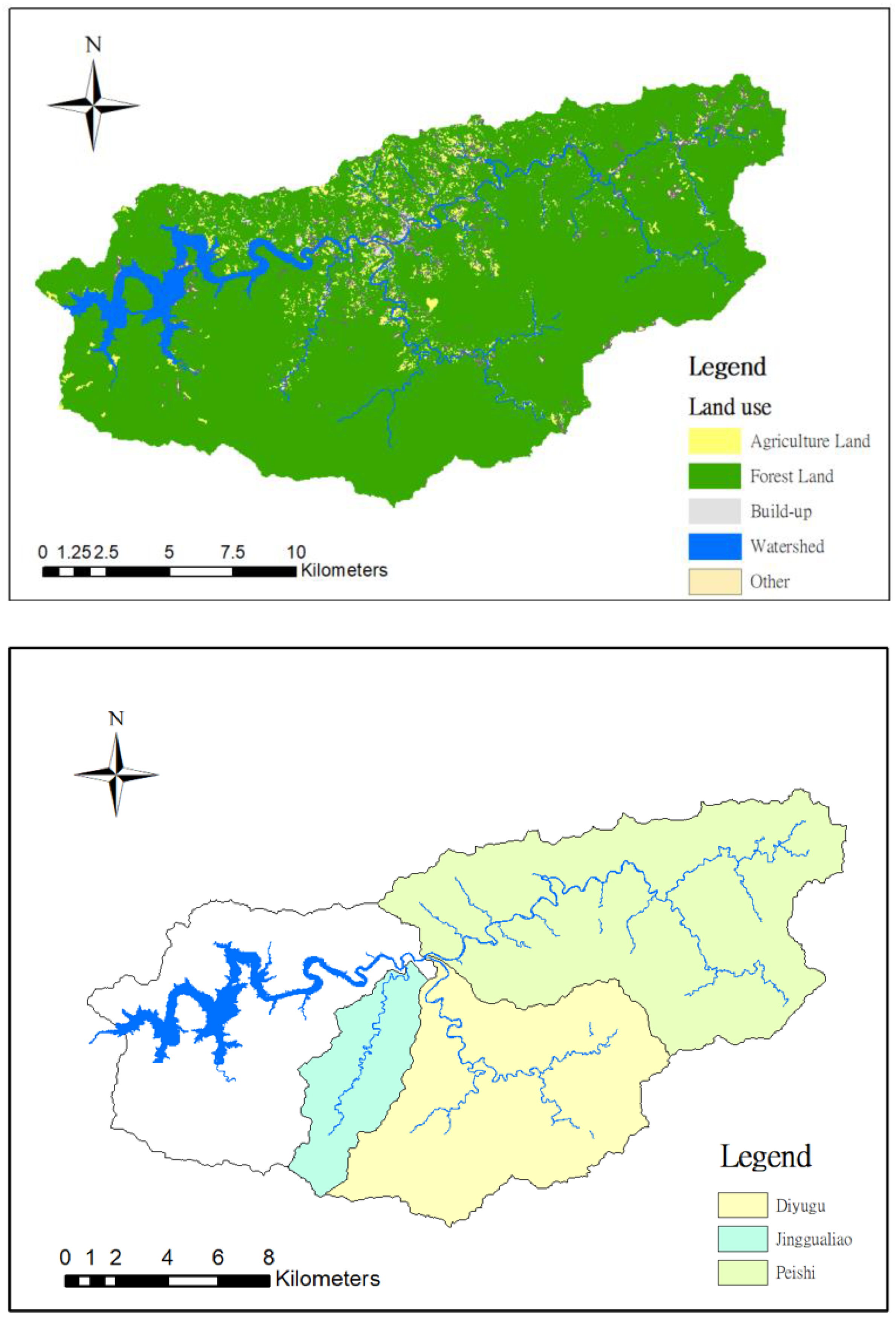
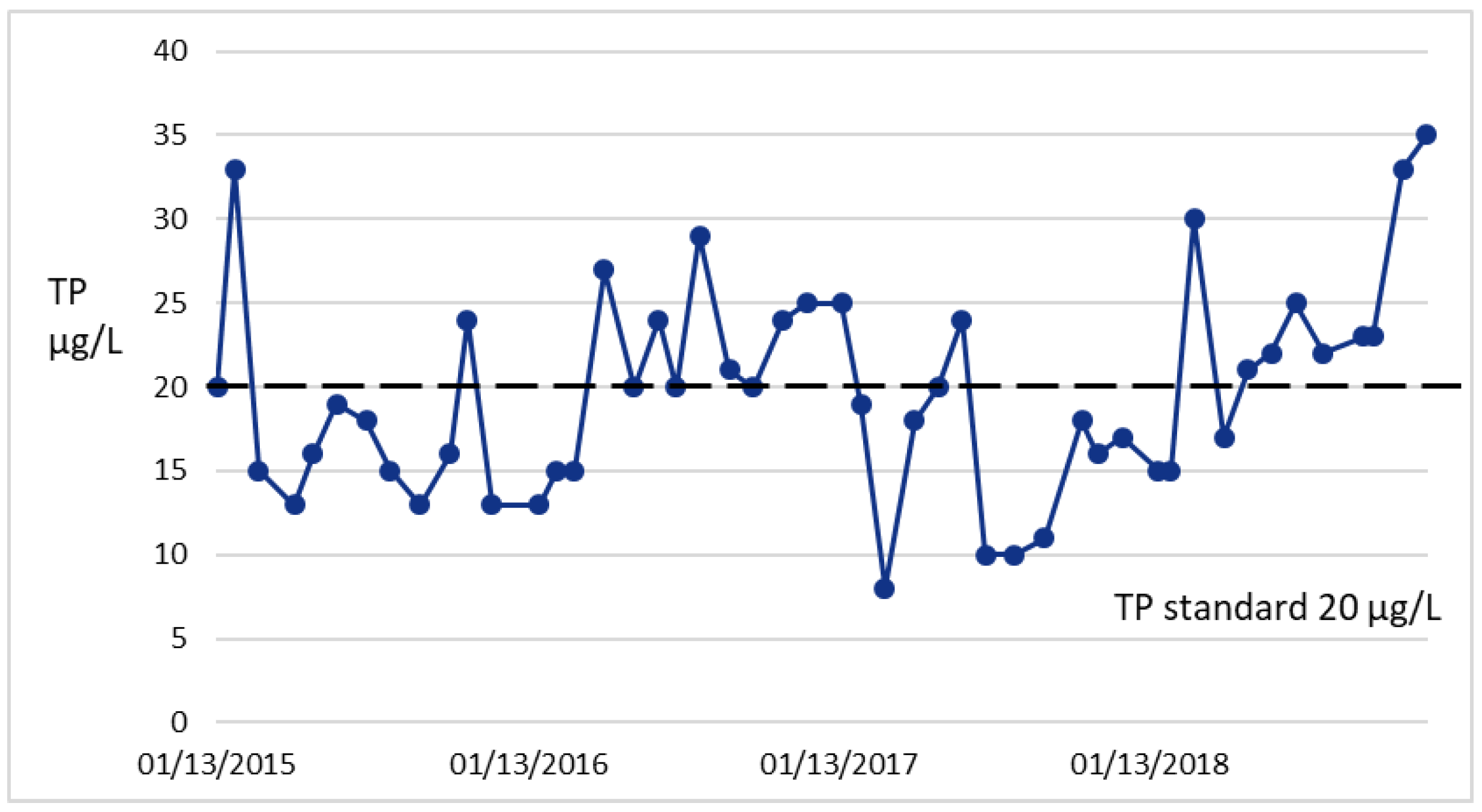
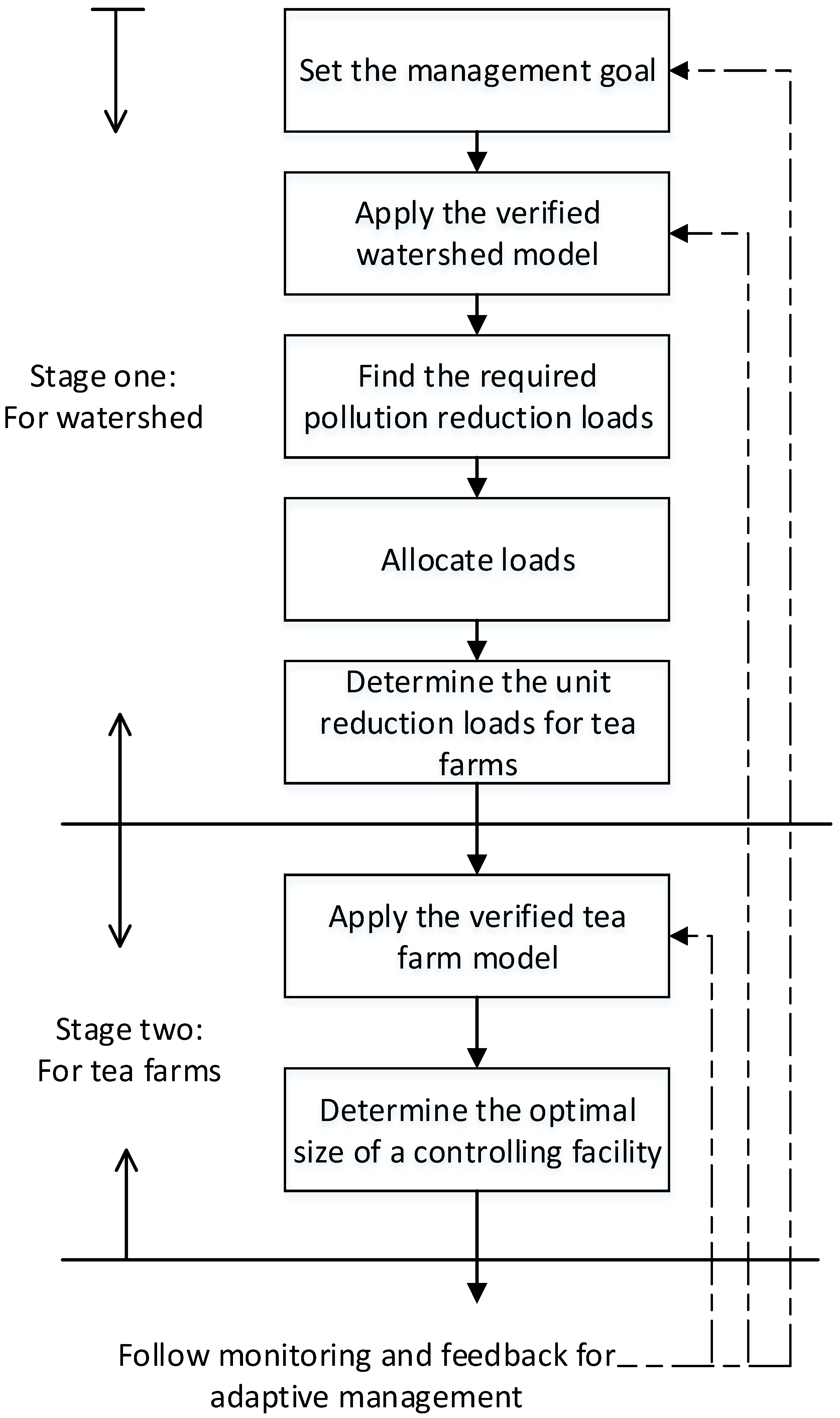
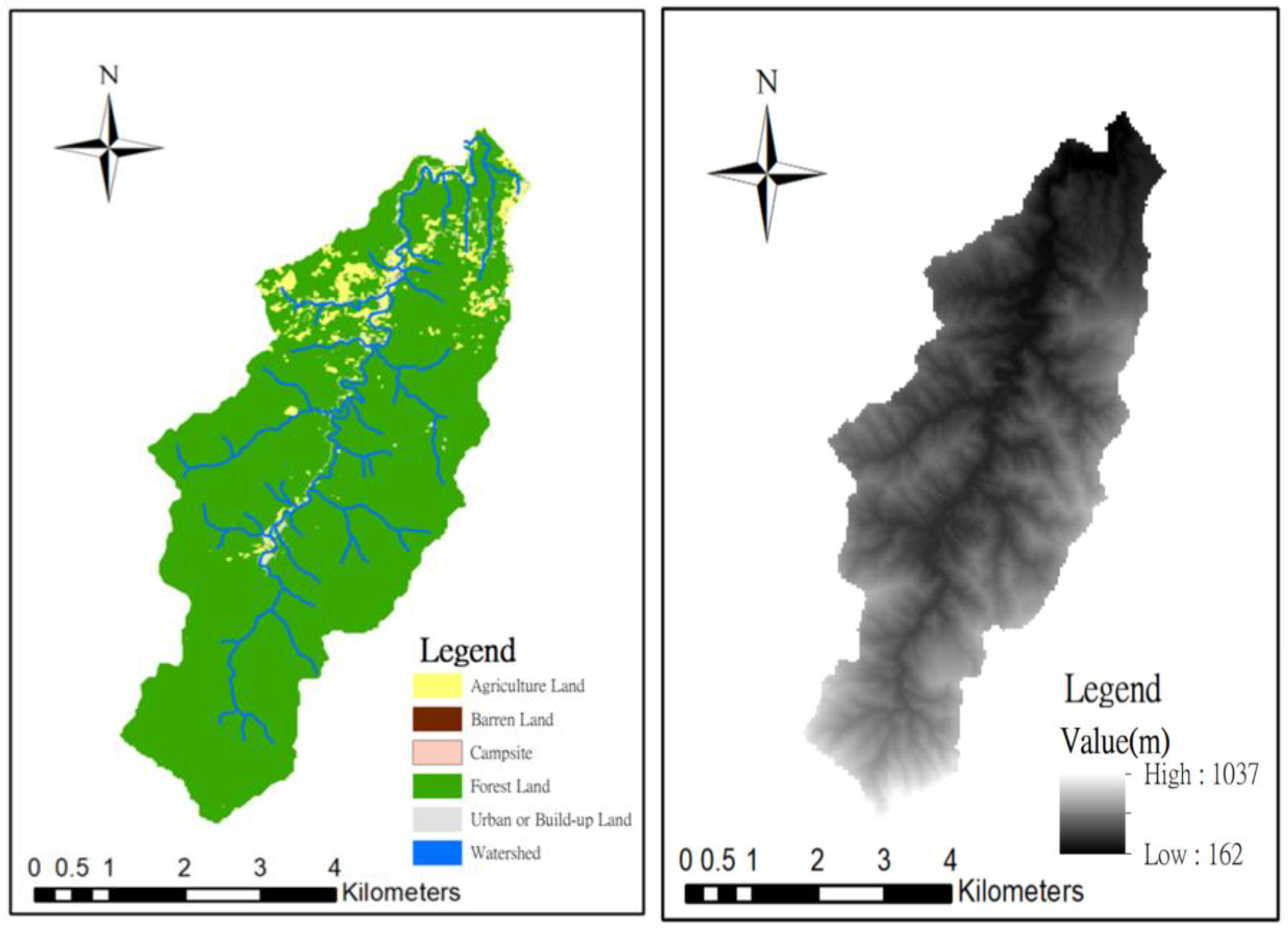
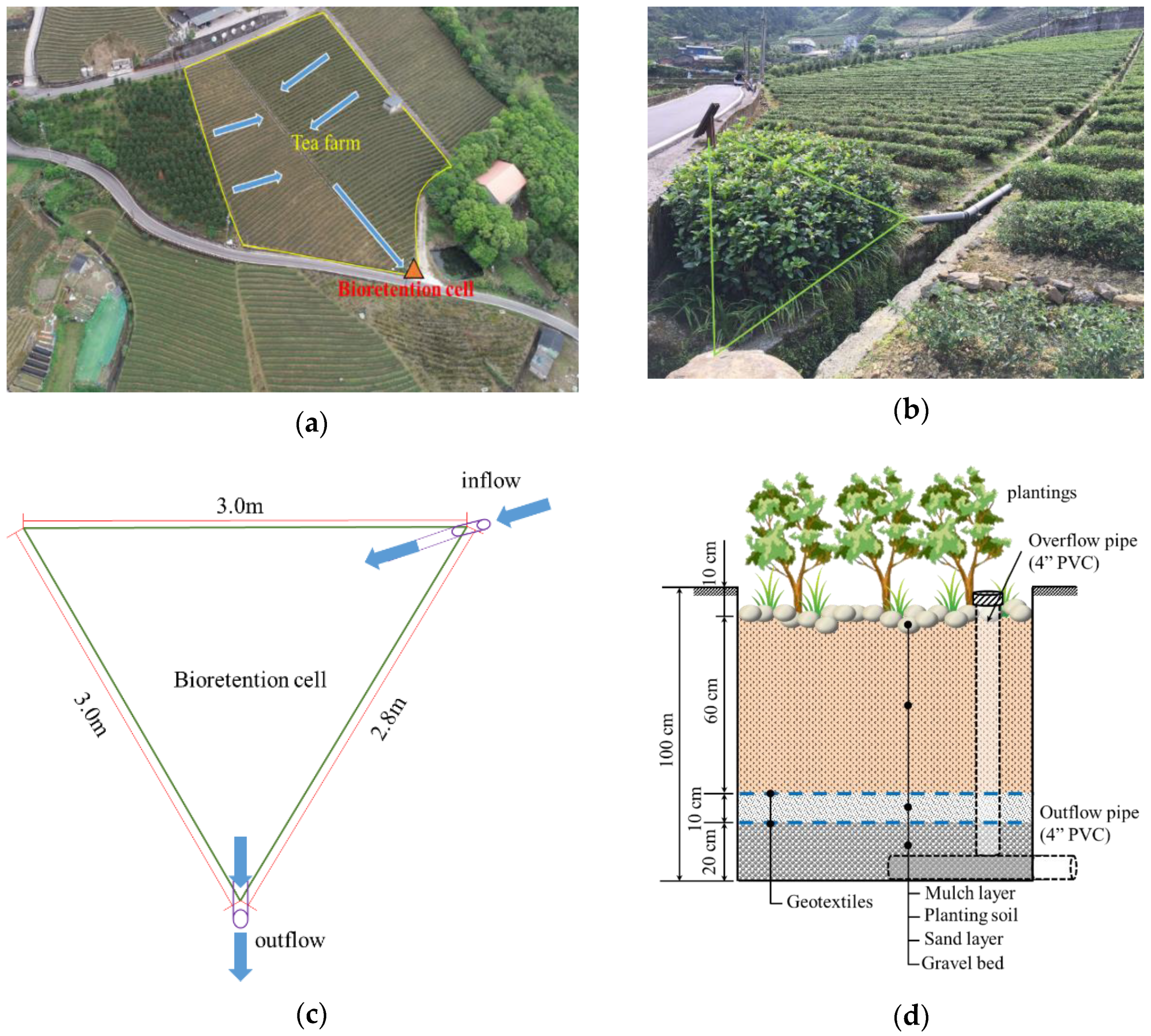
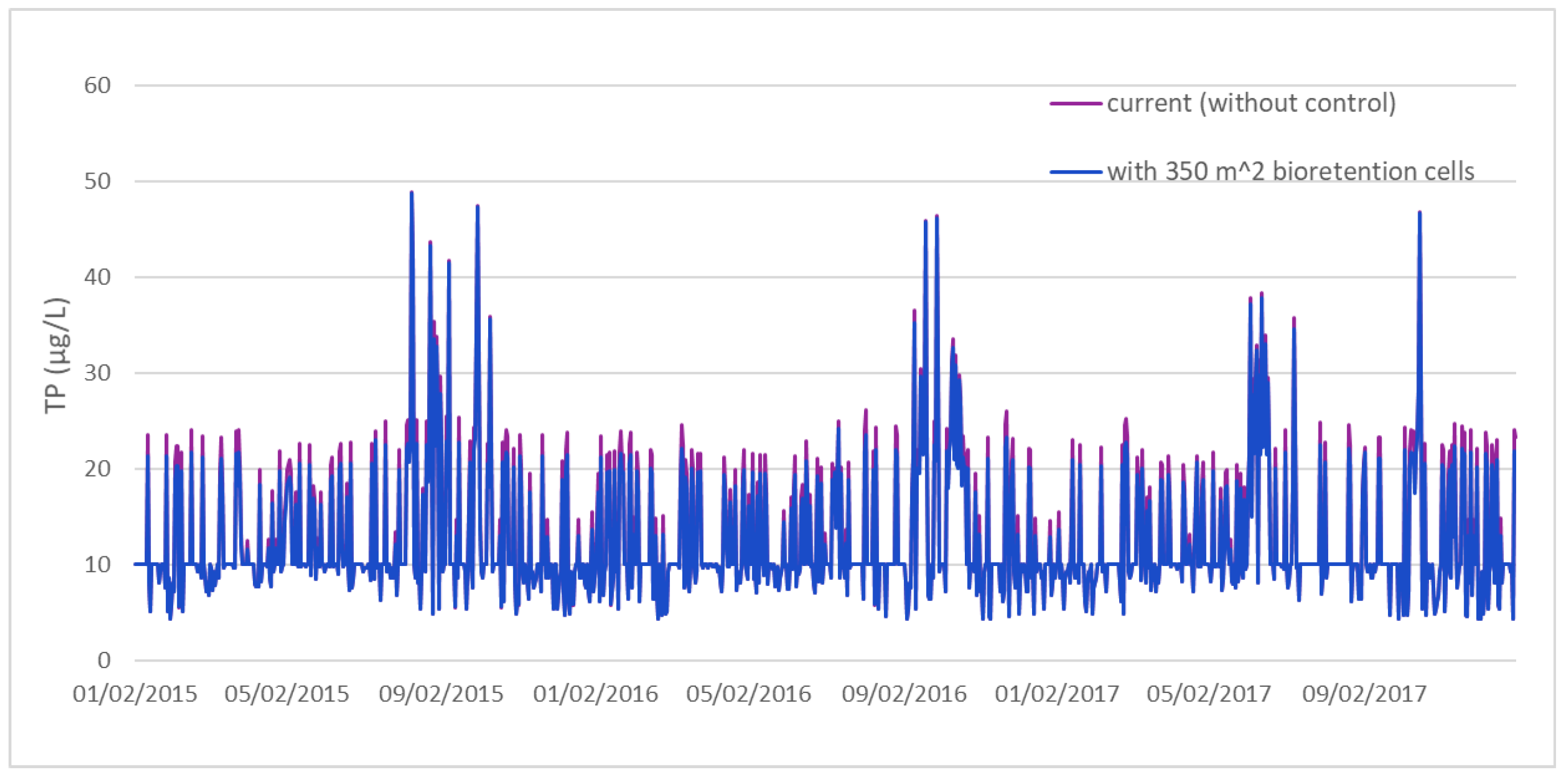
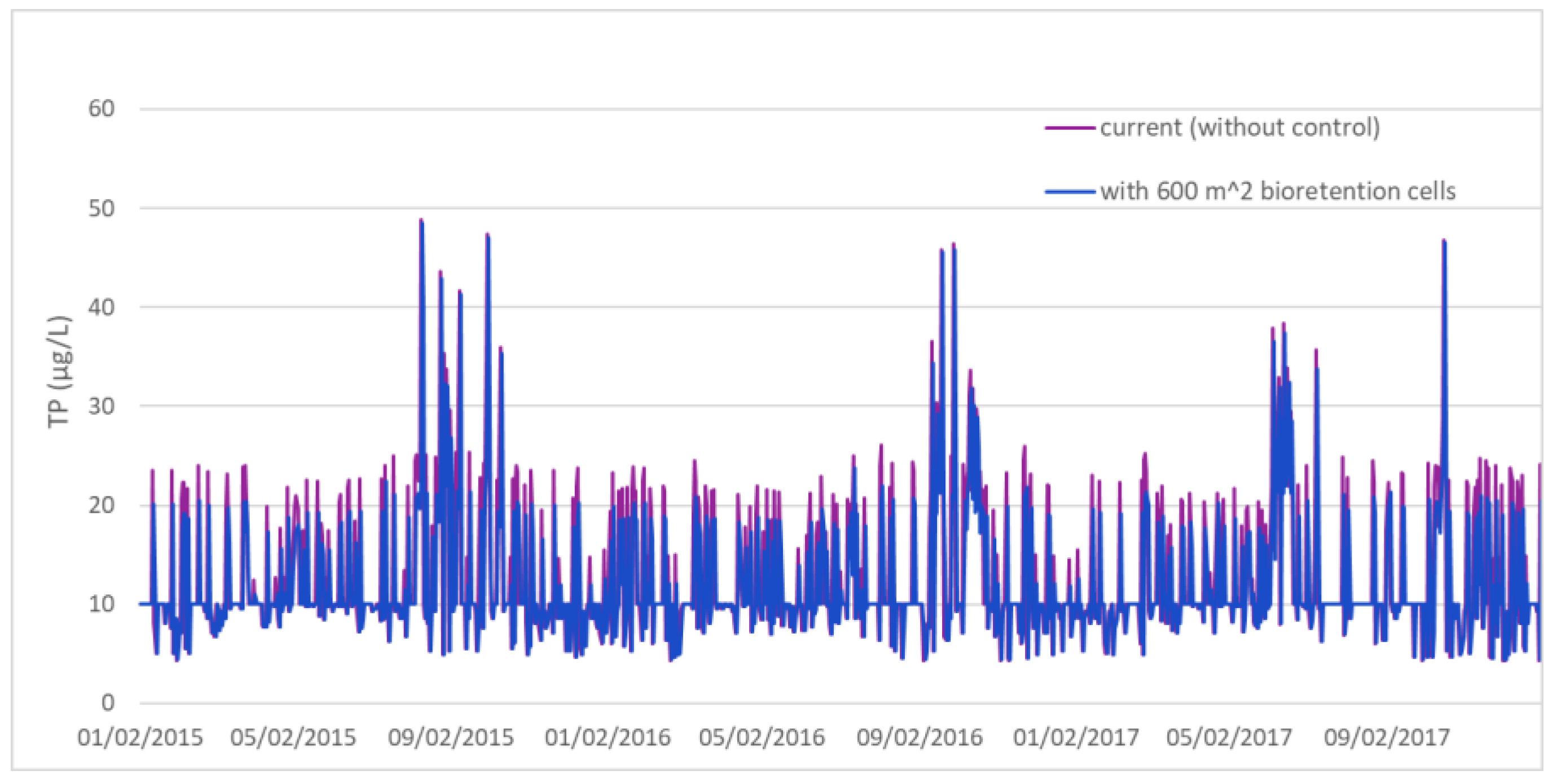
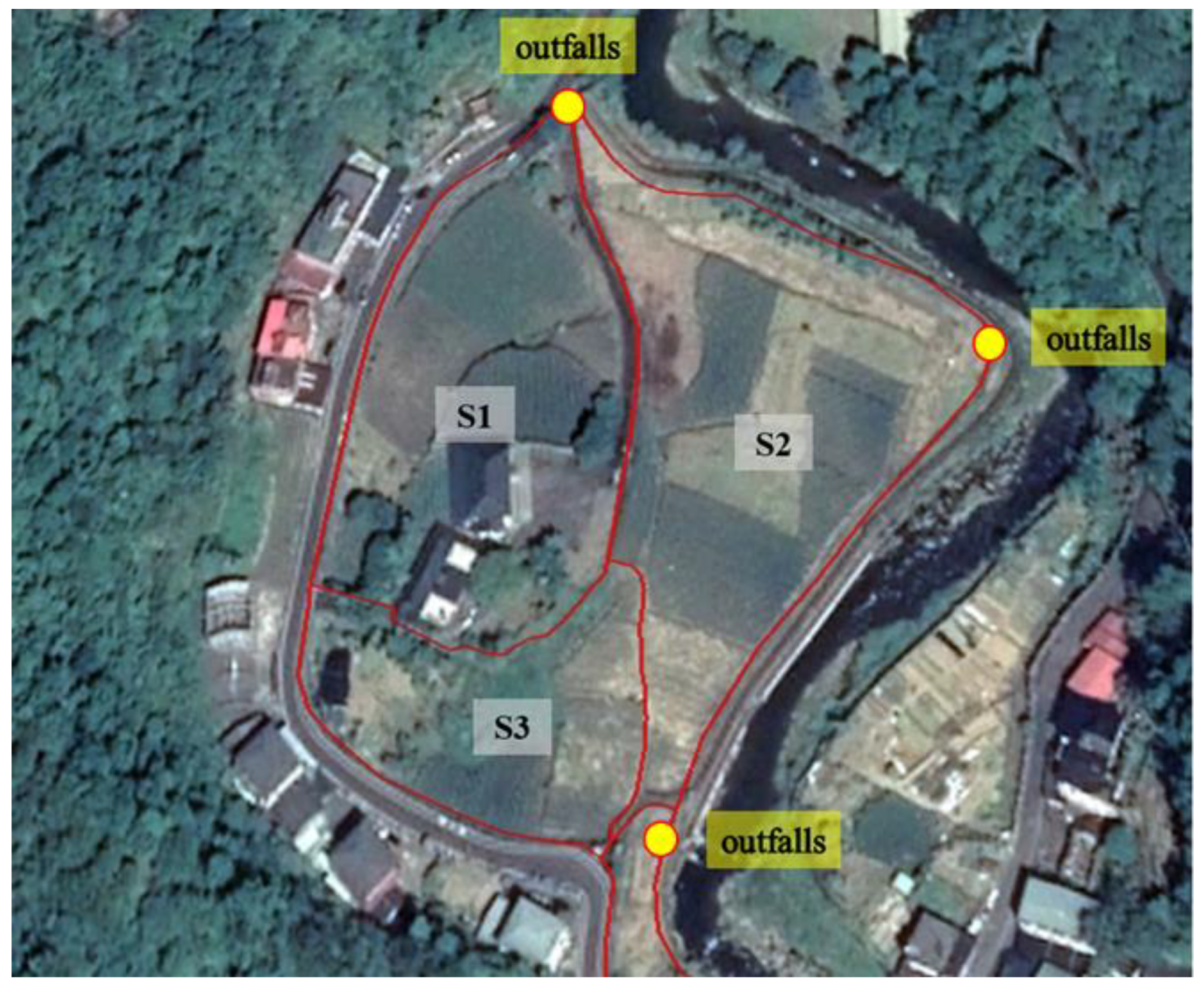

| Year | TP Concentration (μg/L) (n = 12 per Year) | Achievement Rate (The Percentage of Data Less than 20 μg/L) |
|---|---|---|
| 2015 | 17.92 | 75.0% |
| 2016 | 21.08 | 25.0% |
| 2017 | 16.33 | 75.0% |
| Average | 18.44 | 58.3% |
| Year | TP Concentration (μg/L) | Achievement Rate (The Percentage of Data Less than 20 μg/L) | ||
|---|---|---|---|---|
| Observations (n = 12 per Year) | Simulations (n = 365 per Year) | Observations (n = 12 per Year) | Simulations (n = 365 per Year) | |
| 2015 | 17.92 | 15.25 | 75.0% | 82.14% |
| 2016 | 21.08 | 12.05 | 25.0% | 79.23% |
| 2017 | 16.33 | 13.09 | 75.0% | 78.43% |
| Average | 18.44 | 13.46 | 58.3% | 79.93% |
| Year | Bioretention Cell Area (m2) | ||||||||
|---|---|---|---|---|---|---|---|---|---|
| 50 | 100 | 200 | 300 | 350 | 375 | 400 | 450 | 600 | |
| 2015 | 83.2% | 84.1% | 84.6% | 85.44% | 85.2% | 86.81% | 87.09% | 87.64% | 90.4% |
| 2016 | 79.8% | 80.3% | 82.2% | 84.70% | 87.4% | 87.98% | 88.25% | 89.62% | 91.3% |
| 2017 | 78.4% | 79.1% | 80.4% | 81.70% | 83.0% | 82.68% | 83.66% | 84.97% | 88.2% |
| Average | 80.5% | 81.2% | 82.4% | 83.95% | 85.2% | 85.82% | 86.33% | 87.41% | 90.0% |
| Achievement Rate | Average TP Loads (kg/Year) | Required Reduction Load (kg/Year) | Unit Reduction Load for Tea Farms (g/ha) |
|---|---|---|---|
| 79.93% (current) | 534.74 | - | - |
| 85% | 518.22 | 16.52 | 270 |
| 90% | 508.36 | 26.38 | 326 |
| Bioretention Cell Area (m2) | TP Loads with Bioretention Cells (g/y) | Reduction Loads (g/y) | Reduction Rate (%) |
|---|---|---|---|
| 3 | 2055 | 62 | 2.9% |
| 6 | 1992 | 126 | 5.9% |
| 9 | 1931 | 186 | 8.8% |
| 12 | 1871 | 247 | 11.6% |
| 18 | 1756 | 362 | 17.1% |
| Tea Farm Case Study | Unit | S1 | S2 | S3 | Total |
|---|---|---|---|---|---|
| Area | ha | 0.890 | 0.580 | 0.517 | 1.987 |
| Original TP export | g/y | 2118 | 1381 | 1242 | 4741 |
| Required TP reduction loads for 85% goal | g | 240 | 157 | 140 | 537 |
| Required TP reduction loads for 90% goal | 290 | 189 | 169 | 648 | |
| The optimal LID size for 85% goal | m2 | 11.8 | 7.7 | 6.7 | 26.2 |
| The optimal LID size for 90% goal | 14.3 | 9.4 | 8.2 | 31.8 |
Publisher’s Note: MDPI stays neutral with regard to jurisdictional claims in published maps and institutional affiliations. |
© 2022 by the authors. Licensee MDPI, Basel, Switzerland. This article is an open access article distributed under the terms and conditions of the Creative Commons Attribution (CC BY) license (https://creativecommons.org/licenses/by/4.0/).
Share and Cite
Chen, C.-F.; Ho, C.-C.; Liu, H.-F. 1 to 1000 Policy: Controlling Phosphorous Pollution from Tea Farms with Bioretention Cells. Appl. Sci. 2022, 12, 2661. https://doi.org/10.3390/app12052661
Chen C-F, Ho C-C, Liu H-F. 1 to 1000 Policy: Controlling Phosphorous Pollution from Tea Farms with Bioretention Cells. Applied Sciences. 2022; 12(5):2661. https://doi.org/10.3390/app12052661
Chicago/Turabian StyleChen, Chi-Feng, Chia-Chun Ho, and Hsiu-Feng Liu. 2022. "1 to 1000 Policy: Controlling Phosphorous Pollution from Tea Farms with Bioretention Cells" Applied Sciences 12, no. 5: 2661. https://doi.org/10.3390/app12052661
APA StyleChen, C.-F., Ho, C.-C., & Liu, H.-F. (2022). 1 to 1000 Policy: Controlling Phosphorous Pollution from Tea Farms with Bioretention Cells. Applied Sciences, 12(5), 2661. https://doi.org/10.3390/app12052661






